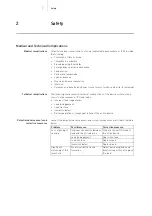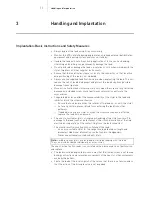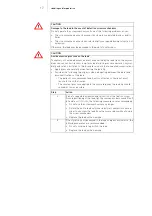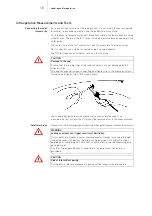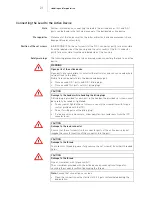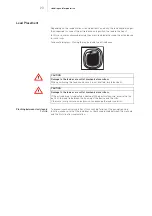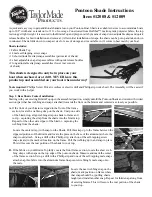
Note:
Tissue damage due to excessive heating usually causes change or loss of the
sensing and pacing function of the implanted lead.
9
Safety
Risky procedures
The table below provides an overview of procedures that present a risk to patients
with an implanted lead or a device system. Take appropriate precautionary
measures and observe the specific instructions listed in the table.
Problematic environmental
influences
•
Increased ambient pressure:
!
!
CAUTION
Damage and failure of the device system
Patients with device systems must avoid situations or environments in which they
would be exposed to high ambient pressures (such as diving or pressure cham-
bers).
The leads are manufactured under standard atmospheric pressure and are not
designed to withstand increased ambient pressure.
Stress resulting from excess pressure may damage the leads.
•
Electromagnetic interference:
Electromagnetic fields may negatively affect patients with device systems as the
intensity and duration of exposure increase. This can have the following
consequences:
— Temporary or permanent effect on or damage to the device system
— Induction of tachycardias, up to and including ventricular fibrillation (in rare
cases)
— Thermal tissue damage (in severe cases)
The patient should be properly informed and instructed on behaviors to avoid
situations with especially risky electromagnetic effects.
Perform a follow-up for clarification if electromagnetic interference is
suspected to have impaired the function of the device system.
In most cases, the problem can be solved by reprogramming the device.
Procedure
Type of danger
Recommendations for risk
mitigation
Therapeutic ultra-
sound
Tissue damage due to
excessive heating of the
lead
Do not direct the energy focus
onto the lead or the device.
Afterwards: perfom a full
follow-up.
External defibrilla-
tion
Tissue damage due to
excessive heating of the
lead
Afterwards: perfom a full
follow-up.
Electrophysiological
ablation
Tissue damage due to
excessive heating of the
lead
Induction of ventricular
fibrillation
Damage to the lead
Switch off the active device
beforehand.
Keep as much distance as
possible between the ablator
and the lead.
Following ablation and prior to
restarting the active device:
perfom a full follow-up.
HF surgery (electro-
cautery)
Tissue damage due to
excessive heating of the
lead,
Induction of ventricular
fibrillation
Do not direct the energy focus
onto the lead or the device.
Afterwards: perfom a full
follow-up.
Lithotripsy
Mechanical effect on or
damage to the lead
Keep energy focus from the
lead.
Afterwards: perfom a full
follow-up.







